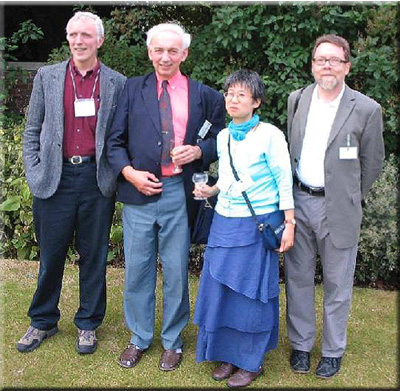Report on the ICHM Special Session in Honour of the Retirement of Ivor Grattan-Guinness: The History of Nineteenth-Century Mathematics
Session at the joint meeting of the British Society for the History of Mathematics and the Canadian Society for History and Philosophy of Mathematics, Clare College, Cambridge University, July 10, 2004.
by Craig Fraser

June Barrow-Green, President of the BSHM, opened the special session with an address documenting and paying tribute to Ivor Grattan-Guinness s long and distinguished career in the history of mathematics. Adrian Rice, programme chair for the meeting, paid tribute to Ivor's many contributions to the field and called attention to the ICHM sponsorship of the special session.
The topic of the special session, the history of nineteenth-century analysis, concerns a field to which Ivor has made fundamental contributio ns. His books on Fourier and French mathematical science, his several edited collections on the history of analysis and mathematical science, and his numerous articles attest to his achievements in this area of mathematical history. Speakers at the speci al session also drew attention to his mastery of archival sources, the sensitivity shown in his writings to foundational questions, and the stimulation and encouragement he has given to younger scholars over the years through his participation at conferences and his travels abroad.
Ivor Grattan-Guinness, "Why Did Cantor See His Set Theory As 'an Extension of Mathematical Analysis'?"
As is well known, Cantor's set theory met a certain amount of opposition, and a lot of indifference, from mathematical colleagues during its development from 1870 to 1895. While especially the theory of actually infinite numbers would have excited shock and awe, and the pretension of general sets some quizzicality, the reasons are not so easy to detect. For from the start Cantor took as the basic concept of his theory the notion of the limit point of a set of points, which was a (marvelously powerful) extension of the theory of limits, staple food for the analysis of his time. In an interesting and thought-provoking discourse, the presenter mused around this topic.
Michiyo Nakane, "Weierstrass's Foundational Shift in Analysis: His Introduction of the Epsilon-Delta Method of Defining Continuity and Differentiability"
The author examined the influences and motivation for Weierstrass's definition of functional continuity first presented in a lecture delivered in Berlin in 1861. This definition was formulated using epsilon-delta inequalities and contained no reference to such intuitive notions as infinitesimally small quantities. The paper showed that it was the intention of distinguishing differentiability from continuity, and not the use of epsilon-delta techniques as such, that was the crucial factor in the new definition.
The following general conclusion was derived from the study. Historians have commonly discussed the development of 19th-century calculus in reference to the concept of rigor. The view seems to be that it was mathematicians' general concern with logical and rather abstract questions that led them to develop modern theories. However, in practice it was the process of solving particular problems that spurred the creation of rigorous theories. Hence it is quite important for historians to identify and describe the work that was done on such problems. For Weierstrass' s seminal lecture of 1861, it was the recognition of the need to distinguish differentiability from continuity that motivated his creation of the modern definition.
Thomas Archibald, "French Research Programs in Differential Equations in the Late Nineteenth Century"
With the renewed development of the French mathematical community in the period after 1870, the theory of differential equations, long of interest to French mathematicians, was carried forward in a number of directions. The well-known innovations of Poincaré in the qualitative theory of ODEs are only the best-known representative of a varied and nuanced set of research programmes. The paper presented an overview of these developments and those involved in them, and unravelled some the threads interconnecting them, their mutual influences, and their effect on early twentieth-century work. An assessment was made of the accuracy of the picture provided by Painlevé, Goursat, Flocquet, and Vessiot in the differential-equations articles of the Encyclopédie des sciences mathématiques.
Craig Fraser, "Mikhail Ostrogradksy's 1850 Paper on the Calculus of Variations"
Mikhail Ostrogradsky (1801-1862) published a paper in 1850 in the memoirs of the St. Petersburg Academy of Science which presented in a general mathematical setting some results from contemporary dynamical theory. From a modern viewpoint, his work may be seen as the mathematical development of certain ideas of William Hamilton and Carl Jacobi. The paper showed that Ostrogradksy's particular technical innovation was to derive the canonical equations for the case in which the variational integrand contains higher-order derivatives of the dependent variables. This derivation represented a non-trivial extension of the existing theory.
Of some foundational interest was the very general viewpoint Ostrogradsky brought to his investigation.
In the introduction to the paper he formulated the objective of his investigation at a greater level of generality than either expository considerations or scientific applications would seem to have warranted. He seemed to believe that the results he obtained in the paper were only one instance of a more general and over-arching formal theory.